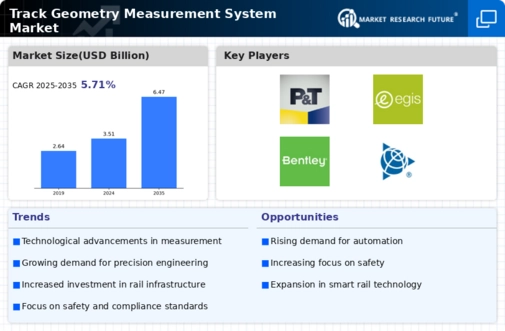Market Trends
Key Emerging Trends in the Track Geometry Measurement System Market
The Track Geometry Measurement System (TGMS) market is witnessing several notable trends that are shaping its current trajectory. One prominent trend is the increasing adoption of advanced technologies in track inspection. Modern TGMS solutions are incorporating sophisticated sensors, machine learning algorithms, and data analytics to provide more precise and comprehensive data about the condition of railway tracks. This trend reflects the industry's commitment to leveraging technology for enhanced safety, efficiency, and maintenance practices.
Interconnected with the technological advancements is the rise of predictive maintenance in the TGMS market. Rather than relying solely on scheduled maintenance routines, predictive maintenance uses real-time data from TGMS to anticipate and address potential issues before they escalate. This trend is gaining traction as it helps reduce downtime, minimize disruptions in rail services, and optimize maintenance costs. Railway operators are increasingly recognizing the value of proactive maintenance strategies facilitated by TGMS.
Another discernible trend is the integration of remote monitoring and diagnostics capabilities in TGMS solutions. With advancements in communication technologies, TGMS can now provide real-time data that can be accessed and analyzed remotely. This allows railway operators to monitor track conditions from a central location, enabling prompt responses to emerging issues. The trend towards remote monitoring aligns with the broader industry shift towards automation and digitalization in rail operations.
Sustainability considerations are also influencing the TGMS market. As the global focus on environmental conservation grows, there is an increasing interest in developing eco-friendly and energy-efficient rail systems. The trend towards sustainable practices is reflected in the demand for TGMS solutions that not only enhance safety and efficiency but also contribute to minimizing the environmental impact of rail transportation.
The market is experiencing a trend towards modular and scalable TGMS solutions. Railway operators are looking for systems that can be easily adapted and expanded to meet evolving needs and changing rail network configurations. Modular TGMS solutions provide flexibility, allowing operators to customize their track inspection capabilities without the need for extensive overhauls or replacements. This trend reflects a desire for cost-effective and adaptable solutions in the ever-evolving rail industry.
The emergence of cloud-based TGMS platforms is transforming the way data is managed and utilized in track inspection. Cloud-based solutions offer scalability, accessibility, and enhanced data storage capabilities. This trend facilitates efficient data management, analysis, and sharing across multiple stakeholders in the rail ecosystem. The shift towards cloud-based platforms is indicative of the industry's inclination towards more connected and collaborative approaches to track geometry measurement.
A noteworthy trend is the emphasis on user-friendly interfaces and intuitive software in TGMS solutions. As the complexity of technology increases, there is a growing recognition of the importance of user-friendly interfaces for operators and maintenance personnel. Intuitive software not only enhances the usability of TGMS but also reduces the training time required for personnel to effectively use and interpret the data provided by the system.







Leave a Comment